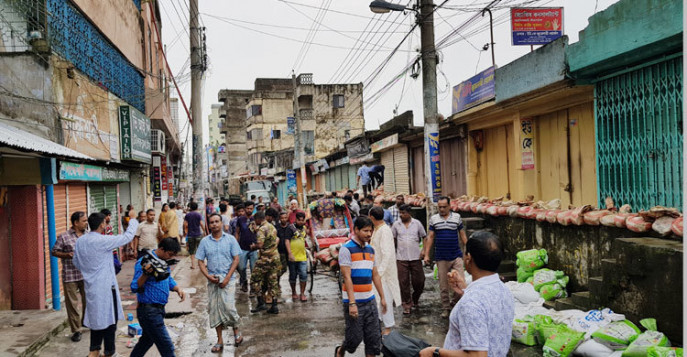Manu river: A blessing turned bane in Moulvibazar
During monsoon every year, floods inundate vast swaths of the region, racking up losses amounting to thousands of crores of taka

The Manu river, which flows through the Moulvibazar district, used to be a blessing. But the river has turned into a bane of the people due to years of neglect and a lack of dredging.
The river was a once a shipping route for small vessels, but now it is riddled with at least 35 river islands. During monsoon every year, floods inundate vast swaths of the region, racking up losses amounting to thousands of crores of taka.
Manu river had an average depth of 20 metres, but it is currently below 10 metres. The river has never been dredged and authorities concerned have yet to take any action regarding the matter despite numerous public demonstrations.
The local people have demanded that the river be dredged soon to prevent flooding this year, as monsoon is just around the corner. They warned of launching demonstrations again if authorities do not take action over the issue.

The Water Development Board has taken up a mega project for the Manu river, but the local people have expressed concerns on whether the plan will be implemented by the Ministry of Water Resources, or be delayed again due to bureaucratic red tape.
According to the sources, Manu is an international river. The river, stretching for 186 kilometres, starts its journey in the mountains of Tripura, India. After its initial rapid passage through the mountainous terrain, it flows through the Moulvibazar district.
The Bangladeshi section of this river is 74 kilometres in length.
The river has an average width of 300 kilometres and has 148–kilometre long protective embankments on both banks. The water Development Board has designated a total of 67 areas, spanning 30 kilometres in the region, as risky.
An analysis of the past 20 years of hydrological data reveals that 250 and 15 cubic metres of water flows through the river during monsoon and dry seasons respectively. Manu faces significant amount of silt and sand buildup in the riverbed due to the difference of water-flow in different seasons and upstream mountain area.

Ninety one percent of the Manu's catchment area is in India, so any rain in the upstream area causes the water to rise by 3-4 metres and cause flash floods in the Bangladesh side. Floods then damage the embankments and inundate local region.
Repair of Manu river's embankment began following the deadly floods in 1984. But the work was not completed due to budget constraints. Even repaired sections of the embankment have become damaged again due to the lack of maintenance.
Local people have complained that the river erosion, combined with flash floods, cause losses reaching thousands of crores of taka every year. They added that the ministry concerned is neglecting the matter, and related project proposals remain tied up in red tape.
Dr Abdul Ahad, former director of Moulvibazar Chambers of Commerce, said, "The floods in 2018 alone caused losses amounting to hundreds of crores of taka to the businessmen in the municipality. During the previous Eid-ul-Fitr, most businesses remained closed for 7-8 days."

Sources concerned said that the local administration sought Tk1,400 crore from the government to build a permanent embankment on the Manu river in 2016-17 fiscal year. But the ministry did not provide the funding.
Following the floods in 2018, senior government officials and ministers visited Moulvibazar and promised the funding, which is yet to arrive. The delay has sparked demonstrations by local people.
Addressing the issue, Bangladesh Poribesh Andolon's Moulvibazar Convener said, "We launched demonstrations after the floods in 2018. It is sad that we have to take to the streets to save ourselves from floods.
"If the inaction over the matter continues, the people of Moulvibazar will take to the streets again."
Meanwhile, Moulvibazar Water Development Board's Executive Engineer Ranendra Shankar Chakrabarty said, "We are working to solve the problem. Proposal for a project with a budget of Tk1,002 crore has been sent to the ministry. It is awaiting approval by the Executive Committee of the National Economic Council.
"The project will help protect the people of Moulvibazar sadar, Rajnagar and Kulaura upazilas from floods."

The project includes river bank conservation with concrete blocks in 67 areas spanning 30 kilometres, construction of a 2.5-kilomtre RCC floodwall from Barohat to Shahbandar, dredging of 12.11 kilometres of riverbed, removal of 35 river islands and reconstruction of the 86-kilmetre protection embankment.
Ranendra further said, "In 2018-19 and 2019-20 fiscal years, nine kilometres of embankment was repaired on an emergency basis with a cost of Tk6.14 crore. This is why Moulvibazar suffered no serious floods last year."
Addressing the issue, Environment, Forest and Climate Change Minister Shahab Uddin assured that the Ecnec will approved the Manu project.
"We will speak with Prime Minister Sheikh Hasina over the matter," he said.


 Keep updated, follow The Business Standard's Google news channel
Keep updated, follow The Business Standard's Google news channel








![Photo collage shows Salman F Rahman's son Ahmed Shayan Rahman [on left] and Salma's nephew Ahmed Shahryar Rahman [on right]. Photos: Collected](https://tbsnews.net/sites/default/files/styles/medium_2/public/images/2025/05/24/salman_f_rahman_son_nephew_collage.jpg)







